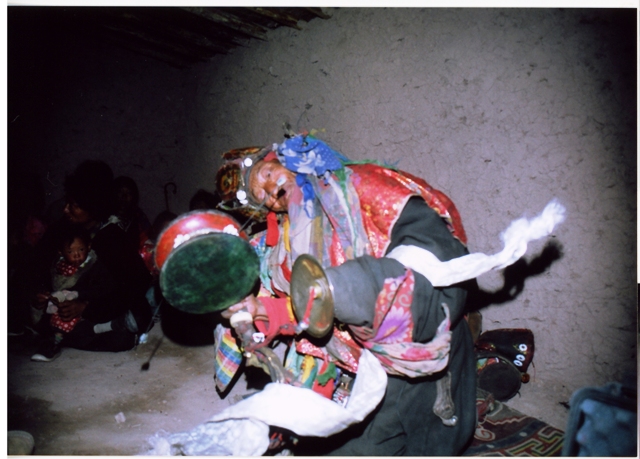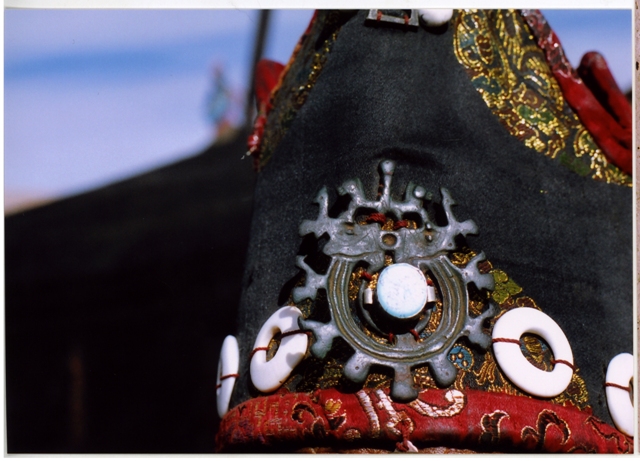
January 2010
John Vincent Bellezza
The Flight of the Khyung wishes you all a very happy New Year! This month the horned eagle trails the sun as its path rises higher in the northern hemisphere. The so-called Farmers’ New Year or bSod-nams Lo-gsar of the Tibetans is now past us. The dross of the old solar year has been swept away and prosperity insured for the new one, paving the way for more bountiful crops and healthier livestock. This is as the Tibetans would see it. The Farmer’s New Year is vigorously celebrated on the periphery of the Tibetan Plateau. However, its observance is hardly marked in core regions of the Plateau such as Lhasa. Typically, this old winter solstice festival is a time when spirit-mediums go into trance to make predictions about the fate of their communities in the coming year.
A senior spirit-medium of Lake Uru
The last two issues of Flight of the Khyung have met with such a good response that I have decided to extend the special series on Upper Tibetan spirit-mediums for a third consecutive month. This time the spotlight falls on Pawo Akar of the old Naktsang district situated in the middle of the Changthang. I had the opportunity to interview him in May of 2004. Born circa 1930, Pawo Akar (not his real name) is a courteous and rather mirthful man. He has four sons and three daughters none of which practice as spirit-mediums.
Pawo Akar explained to me that he first went into trance at 25 years of age. He was a student of his paternal uncle and his wife’s paternal uncle, as both families have a history of spirit-mediumship. His initiation lasted about three years. Pawo Akar’s grandfather Arya ’Bum-me is reputed to have been a great spirit-medium, but he was murdered by Kazakh raiders in the 1940s. It is said that these bandits tried to kill Arya ’Bum-me with bullets but were unsuccessful, so they decapitated him. Arya ’Bum-me’s valuable ceremonial equipment was either stolen or discarded by the Kazakhs. Pawo Akar found the phyi-gling or ritual mirror he uses in the ruins of a Buddhist monastery, while he discovered his chu-gling, another ritual mirror, in the grounds of his encampment. As part of his practice, Pawo Akar has gone on pilgrimage to Mount Kailas on two occasions. A main focus of these trips was the ‘palace’ of the god Gangs-ri Lha-btsan, the rocky mountain that rises above Chos-sku monastery.
Pawo Akar’s eldest son reports that his father goes into trance ten to twenty times a month, so much in demand are his services. Pawo Akar is a vessel for the red mountain gods Gangs-ri Lha-btsan (also called Gangs-ri brag-dmar), Lha-btsan sGo-gangs (a deity of Pre-ta pu-ri in western Tibet), Byang-btsan Rol-pa sKya-bdun and bTsan-rgod Nam-ra. In the trance ceremonies, these fearsome deities employ a colorful array of helping spirits including a peacock, black crane, purplish crane, black horned eagle, purplish horned eagle, wolf with white fur, wolf with red fur, red fox, and a stripped tiger. A divine lammergeyer is used to retrieve the souls of patients stolen by demons, carrying it back to the rightful owner nestled in its wings.

Pawo Akar as the god bTsan-rgod Nam-ra
Like other bona fide Upper Tibetan spirit-mediums, Pawo Akar, states that the main reason for calling upon the gods is to cure illness. To determine the cause of sickness, Pawo Akar sometimes performs dice and rosary divinations while in trance. He reports that chthonic spirits such as the klu and sa-bdag are often implicated as disease-makers. He mostly relies on the grib-sbyang or sucking method to remove diseases. Another curative method entails empowering hot black sand with spells of the black and white horned eagle. This sand is thrown on both ailing people and livestock. Whilst in trance, Pawo Akar also magically activates pills called ‘round pills of the secret mantras’ (ril-bu gsang-sngags) with mystic spells. These pills are made from sacred red ochre and a mineral carbonate (cu-gang) that come from the Mount Kailas area. Fumigation of patients is carried out using black juniper and a rare high elevation herb known as gangs-spos.
The trance ceremony I witnessed was a fast-paced and colorful affair with around 35 people in attendance. Many came from nearby encampments on motorcycles to see the nocturnal spectacle. It was held in a tiny mud-brick building, the only permanent structure in Pawo Akar’s summer camp. The event began as a social occasion with much chatter and light-hearted family banter. This gave me a chance to set up and test my audio equipment. Even after the trance proceedings began the mood was buoyant and more than once laughter punctuated the air. First there were the preliminary invocations to the deities of Buddhism and the local protectors. The saying of these prayers gradually increased in intensity and lasted for 7 ½ minutes. The advent of the presiding deity was expressed in unequivocal terms with Pawo Akar dancing riotously around the room for about one minute. Spectators tossed barleycorns at him to welcome the incarnate god. After his romp through the crowd, Pawo Akar came back to a sitting position to blow a whistle and play his flat-bell and hand-drum.
The god then began to speak through Pawo Akar saying, “Hum!” This holy syllable was followed by nearly a minute of incoherent utterances and then the line: “Hey my friends!” Immediately thereafter the spirit-medium’s intermediary (bka’-lung) posed a question. Pawo Akar responded in a rather noncommittal fashion before announcing the god that he had become:
Anyway, if he has surgery is there any benefit for this painful disease, will it be removed? Yeah, yeah, good luck. [I am] the god of unchanging good fortune, the seven brothers bTsan-rgod Nam-ra. Now, today, the god has descended. Why have you [invited me] today? Yeah, all of you tell me. Yes, individually, tell me what is on your mind. Each god, tell me what is on your mind. Each female tell me what is on your mind.
At this point, Pawo Akar is asked another question. This time his reply was quite dismissive for the focus was on his divine presence:
Yeah, there is nothing to say. There is nothing to say to the old man. I am the god of 500 generations at gSum-khyab bzhi. I am of mDo-stod ’Brong-pa of the six types of the 500 [generations]. mDog byed-kas byed gi yod (an expression of self-depreciation or self-effacement). Really! Others say this is without it being like that. Such things I ’Khor-ba (the name by which the deity refers to himself) can answer if you want. If I answer something incorrectly do not worry. They are to provide for living beings, alms given to the lowly poor. I myself am the root god of the human generations. Is there or is there not such generations? Yes, how is this advice that I am giving you? Yes, is there or is there not one such as him? Yes, the blazing Gangs-ri Lha-btsan, the seven brothers bTsan-rgod Nam-ra, it is like that.
bTsan-rgod Namra through Pawo Akar went on to affirm his devotion to the eight forms of Guru Rinpoche, the Karmapa lineage and White Tara. He then solicited more questions from those in attendance saying, “Then ask me”, with the addition of “byed kas gyis” at the end of the sentence, an imperative construction indicating that the spirit-medium as the deity is addressing those of lower social rank. This question and answer period lasted a total of two minutes. Afterwards Pawo Akar’s speech was incomprehensible for 33 seconds to be precise. He then began the healing aspects of the trance ceremony, seeing several patients that came before him to rest on their knees. Pawo Akar placed his drum on the back of each patient while sucking on his khro-lo flat-bell. When the remedial procedure for the first patient was finished, Pawo Akar spat some blood into a small bowl of water and displayed it to the onlookers. Purportedly, this blood was the cause of the person’s illness. While holding up the blood for all to see Pawo Akar proclaimed:
The blood of chronic disease. This blood was not circulating. [This blood] is turbid and coarse. It is yellow and coarse.
With the completion of the curative rites, the spirit-medium’s intermediary tells Pawo Akar that two people from India have come to behold the god. The spirit-medium turned directly to me asking what I want. I volunteered that I am interested in learning about the history of the klu water spirits. His reply conjured up the majesty and auspiciousness of the klu:
In the mind of Slob-dpon Padma ’Byung-gnas (Guru Rinpoche) and his consort. The manifestation of the klu Ancestor Lineage Female Klu Riches (rGan-rigs Klu Phyug-mo). If I was asked to show how the klu are Buddhist doctrine protectors, how is the klu a Buddhist doctrine protector? The doctrine protector klu. Ah, the golden fins of the gliding fish, the klu of the golden fins fish, that is the klu that provides in every direction. Ah, there is such a klu. Ah, of the klu. It is the klu doctrine protector of all directions. It is not the klu of one, two or only a few. It is the klu of all dimensions, it is for all dimensions.
Pawo Akar then reasserted his divine identity in what amounted to a benediction directed to all those present. He declaimed:
Ah, I am like those in attendance. I am the old mighty one (btsan-po) friend, the good god of 500 human generations. I am the god of 5[00] human generations. I am such a protector. I am such as this, the one who is generous to the beings of the six realms, generous to the lowly poor, to all beings of the six realms (followed by two incomprehensible lines). I am such as this, the one who is beneficial to living beings. Ah, is it or is it not like this? Speech of the divine white rock formation. I am the god snow mountain protector, the god Dharma protector. I, the mighty one. It is like that.
Next, Pawo Akar described the significance of the ancient copper alloy fibula mounted on his hat:
This is the thunder stone of nine [metals] mixed together, which was formed in space. This is the thunder stone with the eyes of the black and white horned eagle. It is a treasure given to me by someone. There was such a treasure given.

A fibula featuring a pair of lions and six birds affixed to the ceremonial hat of Pawo Akar, protohistoric period or early historic period. This fibula is said to be an emblem of the warrior spirits or dgra-lha.
Upon describing his celestial hat ornament, Pawo Akar conducted more healing rites, lasting a total of approximately 22 minutes. These activities entailed vigorous interaction between the spirit-medium and his audience, behind which lies a social bond many centuries old. The last five minutes of the trance were dominated by a chant describing the retreat of the deities from Pawo Akar’s mind-stream. Almost all of this final sequence of the ceremony was inaudible.